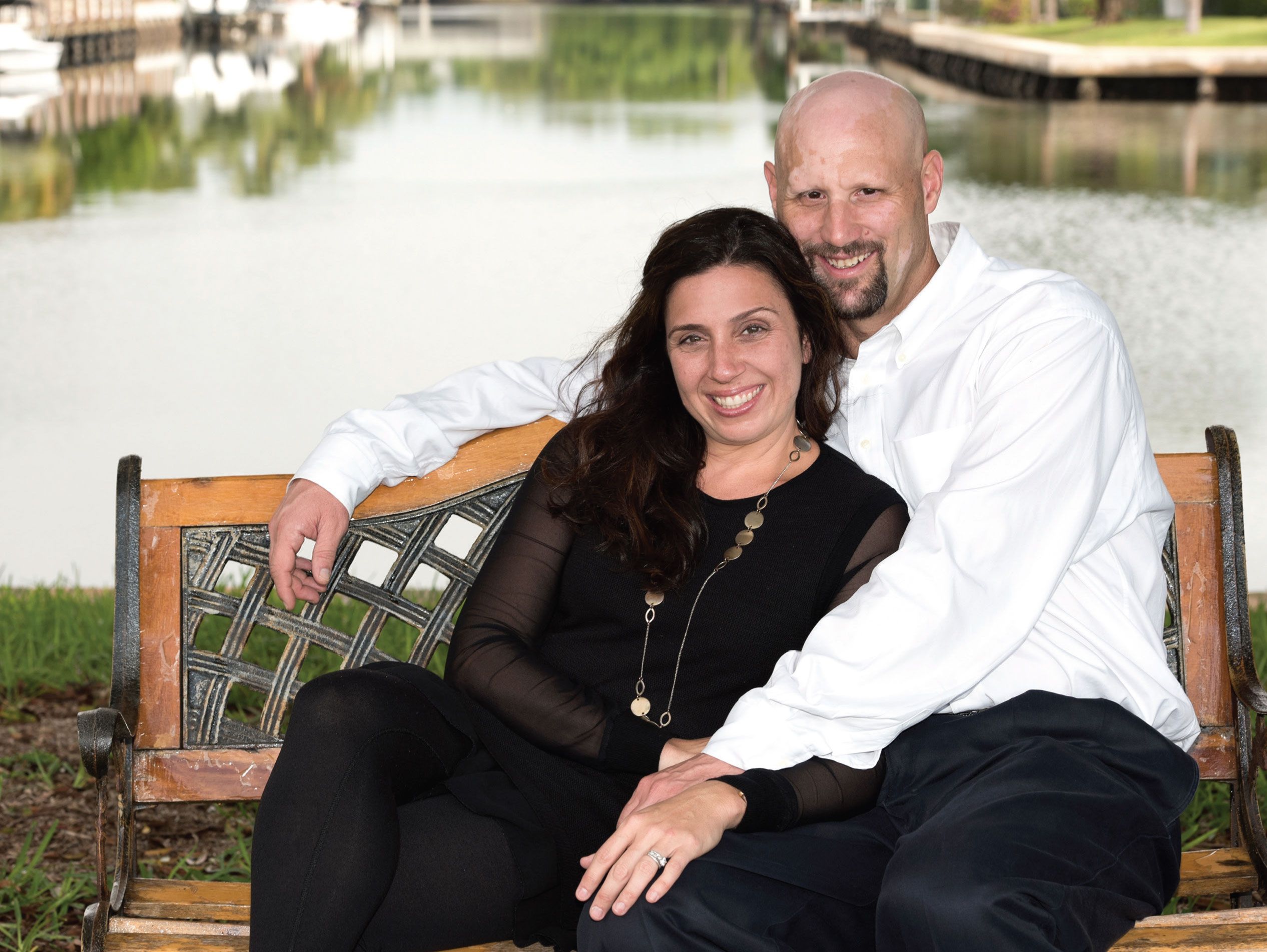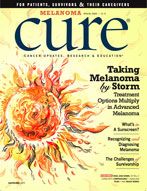Publication
Article
CURE
First Words: Communicating With Loved Ones After a Cancer Diagnosis
Author(s):
After a cancer diagnosis, patients and their caregivers must decide how much information to share with loved ones, and who should manage the communication plan.
T.J. and Jennifer Sharpe know the joys of having a close family. But they also know when they need to work through something apart from the crowd.
It’s something the Florida couple learned while T.J. was being treated for stage 4 melanoma 15 years ago.
“When we knew a particular treatment was going to be tough, or if a meeting with a doctor might deliver bad news, sometimes we wanted to go through that with just the two of us, so we could process the information separate from the reactions that our families would have,” Jennifer says.
Striking a balance between privacy and public knowledge is an inescapable part of the melanoma journey, and of the cancer experience in general. Some patients are very private and want to keep the news to themselves; others find comfort in talking to family and friends. Either way, in the midst of shock and disbelief, there’s a sudden need to manage communications.
PHOTO BY KIM RUOFF

T.J. and JENNIFER SHARPE found it helpful to set boundaries limiting the involvement of relatives in their treatment decisions. [PHOTO BY KIM RUOFF]
First, patients and their caregivers need to agree on how much information to share, how to share it and whom to share it with. Then — depending on the patient’s age, health status, ability to communicate and general mood — they need to determine how much of that gatekeeping the patient feels up to accomplishing, and how much should fall to the caregiver.
Setting early expectations with family, establishing communication patterns with friends and having regular conversations are important tools that can ease the burden on both patient and caregiver. Ultimately, they are a team, balancing the needs of the patient, the demands on the caregiver and the real need of the patient’s support network for information.
Clinical social worker Amy Sales, a grief counselor at the Sidney Kimmel Cancer Center at Johns Hopkins, suggests that the time right after diagnosis is the best in which to set boundaries on future communications. Setting others’ expectations helps the patient and caregiver avoid a neverending string of visits, phone calls and texts. This can be as simple as saying “We will send out a note after each doctor’s visit, and sooner if something happens.”
Sales recommends informing people about a cancer diagnosis in this order: children, job, extended family and then friends. Especially when loved ones live far away, she suggests setting an expectation that the patient and caregiver will need time to assimilate and understand information they get from doctors before sharing it. Without such plans, problems can arise, says Sales, the author of “Walking on Eggshells: Caring for a Critically Ill Loved One.”
“Many people try to keep it private,” she says. “But once one person finds out, the news spreads like wildfire. Rumors fly and people in the inner circle are hurt at being excluded.”
To some extent, it can be beneficial to everyone if patients share information about their illness and then accept the offers of help that will inevitably follow. Although many patients have a difficult time accepting help, Sales cautions, they should remember that human nature makes it easier to give than to receive.
Striking a Balance
Her advice: “Let people give back what you’ve given, then pay it forward. Give people a gift by letting them help you.”Unfortunately, sometimes being open about a cancer diagnosis and treatment plan can complicate life for patients at an already stressful time.
That was the case for T.J. Sharpe and for Jennifer, who cares for him while also working as an attorney and sharing the duties of parenting their young children. During T.J.’s treatment, the couple’s close relationship with, and proximity to, his parents occasionally caused some friction.
The Sharpes were particularly frustrated when their family members communicated directly with doctors, without T.J.’s knowledge. It’s a tendency Sales has seen in families she’s worked with, too.
“Being grown adults with children of our own, it was frustrating to have a concerned parent disregard the information we were giving them and the course of action we chose to take, and bypass us to have private conversations with our doctors about our treatment decisions,” Jennifer says. The couple resolved these situations via several heart-to-heart talks, sharing all parties’ frustrations and resetting boundaries.
In such cases, social workers may suggest a conference including the medical team, the patient and anyone else the patient wants there, to clarify the decision-making process. Social workers can also help communicate a patient’s wishes to his or her medical team — making it clear, for example, if there’s someone a patient does not want his information shared with.
Communications often break down during the most difficult of conversations, when hope is fading that a patient will be healed, Sales adds.
“Niney-nine percent of the time, everyone knows what’s going on,” she says. “Most doctors aren’t good at saying there’s nothing left to be done. That’s when the social worker may help by facilitating the conversations.”
When Sharing Helps
She finds that the dynamic between patient, caregiver and others is unique in each circumstance. The social worker must determine who requires primary support, the caregiver or the patient, and in what proportions. Often, just listening to the caregiver’s needs and worries makes a difference.When Jeff McAlear, of Florida, was diagnosed with melanoma in 2004, he didn’t hesitate to tell people, and his wife, Debbie, fell into step with him.
Debbie struggled silently with her own fears. “As a hospital clinical director, I knew too much about melanoma, and what some of the bad outcomes could be,” she says. Still, she helped to establish the level of communication that made her husband comfortable. “I felt it was up to Jeff, and my role would be to support and respect what he wanted,” she says. “We never kept it a secret or had much conversation about who, how much or what to say beyond our immediate family.”
Jeff gave family members the information first. “Both my wife and I informed our daughter and son (ages 23 and 20 at the time) in person. I also called my mom and told her over the phone. Once immediate family members, work peers and my boss were informed, I knew the grapevine would take care of informing others.”
When the grapevine led back to Jeff, he was happy to talk about his experience, which included skin and lymph node removal surgery, a relapse a few months later, and several failed skin grafts before an ultimately successful graft. He has been cancer-free since 2005.
“Whenever I was asked about my situation, I was comfortable with sharing,” he says. “Actually, I kind of enjoyed explaining the process and procedures and the reasons for them. I still welcome discussions today.”
Despite their difficult experiences early on after sharing treatment plans with immediate family members, the Sharpes have also hit their stride when it comes to disclosing information about T.J.’s health status.
T.J. and Jennifer initially started sending their supporters emails, and then moved to a blog as interest grew (www.philly.com/patient1). T.J. recently celebrated the 15th anniversary of his diagnosis by receiving his 43rd infusion of the immunotherapy Keytruda (pembrolizumab). He is well enough to write and participate in outreach and research conferences while parenting and cooking for his family.
As T.J.’s caregiver and his partner in communicating information about his disease, Jennifer says that joining a support group has been very helpful to her. In particular, she saw the wisdom in a 2013 Los Angeles Times article posted on her group’s website, which explains what to say when upset about a loved one’s cancer — and to whom. The information, she says, can help caregivers like herself to guide others in saying, and writing, the appropriate things.
According to the article by Susan Silk and Barry Goldman, it’s fine for loved ones to cry and express their hurt, fears, frustrations and anger about the cancer — but not to the patient, or to anyone closer to the patient than themselves. Rather, it’s best to vent to someone less connected to the patient, who is therefore less likely to be upset by the outpouring.
Meanwhile, when interacting with the patient and his immediate family, those who care should simply offer comfort and support.
C
“As you get closer and closer to the person who is going through a terrible time,” Jennifer summarizes, “you ‘comfort in and dump out.’”





